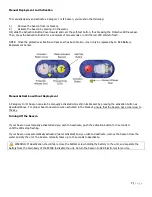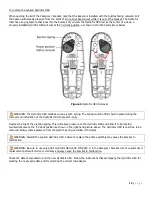
16 |
P a g e
5.
Extended GPS test
The beacon may be further tested for GPS functionality once every six weeks up to a maximum of 84 times in the 10 year
lifetime of the battery. This test is not necessary at any time in the life of the beacon, but is made available in the event
that the beacon owner wishes to verify internal GPS engine viability. To properly perform this test,
the beacon must be
outside with a clear view to the sky.
An extended GPS test is initiated by pressing the self-test button for six (6) seconds. There will be an initial brief green
LED flash followed approximately five (5) seconds later by three (3) short green LED flashes and three (3) beeps to
indicate that the extended GPS test has started. The self-test button should then be released.
During the extended GPS test, the red LED will blink to indicate that the beacon is searching for a good GPS fix. Upon
completion of the test, a 406 MHz Self-test message with the GPS position will be transmitted, and then a long green LED
and beep will indicate that the extended GPS test was successful. If the beacon is unsuccessful in acquiring a good GPS
fix, a 406 MHz Self-test message with default position data will be transmitted, and there will be a long red LED flash and
four (4) beeps.
After the maximum number of extended GPS tests has been reached, the beacon will no longer perform the extended
GPS test. There will be a brief short green LED flash followed approximately five (5) seconds later by three (3) short red
LED flashes and three (3) beeps to indicate that it is no longer possible to run the extended GPS test.
6.
Annual testing for SOLAS vessels, IMO MSC/Circ. 1040
SOLAS regulation IV/15.9 requires annual testing of 406 MHz satellite EPIRBs. These tests can be performed by certified
ACR Battery Replacement Centers. Visit ACR’s website at



























